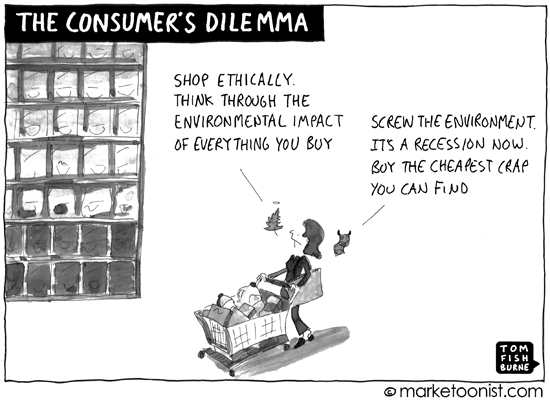Is sustainability a luxury for the wealthier?

I have been thinking about my personal finances a lot, lately.
I dedicated the whole of February to money wisdom. I worked out that I have about 25 years (everything going well) of working life still in front of me, and I want to ensure I reach my golden years in a comfortable enough position to enjoy them.
By observing my spending habits more closely, I realised that many of my choices could be defined as ‘first world’.
I’m a minimalist and I’m not a fan of shopping for the sake of it. But my sustainability drive takes me to my local zero-waste shop often to find products without plastic packaging. Generally speaking, I refuse to support an economy that uses an enormous amount of energy to dig rotten dinosaurs and transform them into something that gets used for ten minutes, then thrown away only to hang around in the oceans for hundreds of years.
Sustainable products, however, come at a premium.
Loose pasta, rice, soap, toothpaste, nuts cost more if bought from a local, small independent business which has its heart in the right place, than from your big supermarket.
As we well know, supermarkets buy in much bigger wholesale bulks at lower prices, that impose outrageously low prices on farmers (recently, Italian streets have been inundated by litres of milk by farmers protesting about the low prices imposed on them by supermarkets). Supermarkets don’t necessarily stock the most sustainable, ethical products, and have a lot more wriggle room than the small shops in the way they manage their overheads.
Conscious consumers face a conundrum between ethical and economic choices.
And that’s not just about groceries. The same choices have to be made for fashion purchases: the documentary ‘The True Cost’ tells the terrible story of how cheap, fast fashion clothes are produced, and of how the price of clothing has been decreasing for decades, whilst human and environmental costs have grown dramatically.
Tough choices extend to construction, where numerous studies have been carried out to establish how much more sustainable building costs, and the average is between 2% and 12%, depending mainly on location.
So what is the solution for those that want to live as sustainably as possible without breaking the bank?
The solution is the most sustainable choice of all: not buying. Not building. Not doing.
Before you start having a go at me, think about it: sustainability unfortunately still is a premium choice.
In the majority of cases, this is because:
a) It currently costs more to produce any product sustainably (that includes fair and ethical production and trading, higher quality materials / ingredients, choice of environmentally friendly packaging, smaller batches, new production processes, slower / artisan production, and so on);
b) Sustainable products give the perception of a finer lifestyle, of niche, higher quality products, which as such, have a higher price tag attached.
In this perspective, choosing not to buy, not to build new, and to reuse or make do instead, are much better options than buying sustainable products.
OK, I can’t make my own rice or lentils, but I can certainly make my own house cleaning products (vinegar and lemon being my preferred choice of ingredients), and many other consumables. In the past I have made my own pasta, stock cubes, clothes, lip balms, moisturisers, shampoo, toothpaste, gifts, baby products and toys from pre-loved baby clothes…and I promise, I’m not wonder woman.
Making do and getting creative with what you already have and buying only a few essential items produced sustainably which last a long time or are of higher quality (or better still, second hand items where possible) is, to me, a much better choice for the planet – and your wallet.
Likewise, in construction, refurbishing, re-purposing, retrofitting and reusing are pretty much always better choices than building new, both from environmental and economic points of view. Less virgin materials, less waste and shorter construction times make refurbishment attractive when the existing structures are sound and the future uses are compatible with them.
Of course, bad refurbishments can also have a significant impact on the environment. But there are a few choices that can be made to ensure the refurbishment is as sustainable as possible. These include (and this is not an exhaustive list):
Choosing low embodied carbon materials and solutions, recycled and reused materials;Thinking about ease of maintenance of elements of the building that will likely last for decades, to avoid replacing them often, e.g. facades;Choosing durable materials for structural elements, like roofs and external envelopes;Thinking about flexibility of internal spaces and location of mechanical and electrical elements for ease of access and maintenance;Generally speaking, considering the life cycle of the refurbished elements.
Up to this point, I might not have written things that are particularly ground-breaking or revolutionary, and probably the old mantra ‘reduce, reuse, recycle’ has popped up in your head right now.
But still today, believe it or not, it is not always so obvious in the commercial world we live in.
In this respect, I invite you to read a great article published on dezeen.com about the new IKEA store in Greenwich, London, claimed by the Swedish retail giant to be its greenest yet.
The article brilliantly opens with: knocking down one sustainable building to build another is nonsensical.
This IKEA store has been built by knocking down the Stirling Prize shortlisted Sainsbury’s Greenwich supermarket, the first ever supermarket achieving a BREEAM Excellent certification. Sainsbury’s Greenwich was an amazing sustainable building built only 17 years before being knocked down, designed by the late Paul Hinkin, when he was working for Chetwoods Architects.
What a waste of resources, intellectual and material efforts, money and carbon dioxide.
So, yes, sustainability seems to be a luxury for the wealthier but it doesn’t have to be.
The most sustainable choices are often the cheapest, most boring, simple and less actionable ones.
